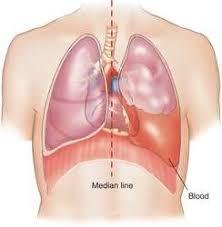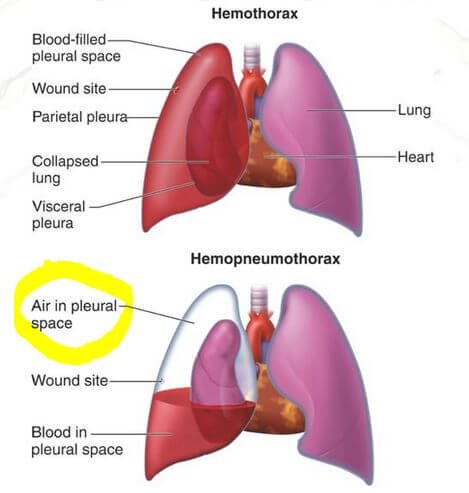Definition
Hemothorax is a condition where blood accumulates between your lungs and chest wall. This region where blood pools in your body is known as pleural cavity. The increased accumulation of blood in this space can cause your lungs to collapse due to pressure exerted on it by the blood1.

Hemothorax can occur after major injuries to your chest or heart and lung surgeries. When you have this condition, you may not notice the symptoms on the spot. This condition is serious and needs quick medical attention.
Causes of Hemothorax
There are many causes of hemothorax such as2, 6, 7
Trauma
Injury to the chest is the most common cause of hemothorax. This occurs when your chest receives an abrupt and powerful impact. Examples of chest injuries are being involved in an accident and falling from a tree on your chest. Another injury is being stabbed or cut in your chest.
These injuries can damage the blood vessels near your chest, lungs and the chest wall. This permits blood to seep out into your chest hollow space and exert pressure on your lungs.
Surgery
Hemothorax can happen as a result of complications that arise from heart, lung and chest surgeries. During operation, the doctor can accidentally cut some blood vessels around your chest. This causes blood to leak into the chest opening and cause pressure in your lungs.
Cancers
Tumors growing in your lungs or chest can cause blood to buildup between the chest wall and the lungs. The overgrowth of tumors in the lungs exerts pressure on the lungs forcing it to collapse. Similarly, tumors developing in your chest wall can contribute to hemothorax.
Ehlers-Danlos syndrome
This is a hereditary condition that affects your connective tissues. These tissues support and structure bones, organs, blood vessels and skin. They are made up of collagen (a type of protein), cells and fibrous material. Several genetic conditions cause Ehlers-Danlos syndrome by impairing production of collagen.6
There are many types of Ehlers-Danlos syndrome and each affect a certain area of your body.
Pleural effusion
It refers to excess accumulation of fluids in the cavities between your chest opening and lungs. Normally there is little fluid in this space to grease the lungs as it expands in the chest during breathing.7
Pleura are thin membranes that cover the exterior of your lungs. When pleura are infected or irritated, they produce excess fluid which accumulates in the space between your lungs and chest cavities.
Apart from infections, certain types of cancers can cause pleural effusion. Breast and lung cancers are the most common cancers that cause pooling of fluids in your lungs.
Symptoms
Hemothorax can cause the following signs and symptoms4:
You feel pain or heaviness in your chest. You may feel nervous or anxious. You may have trouble or difficulty in breathing or breathe too fast. Your heartbeat may beat faster than usual. Your skin can turn pale and you may have fever.
Diagnosis
Your health professional can conduct several tests to find out the cause of your bleeding: These tests include2:
Computed tomography scan
This imaging test is used to take detailed images of different structures in your lungs and chest. The images are examined by the doctor to check for any causes of bleeding.
X-rays

X-rays can be done to look for any broken structures in your chest that may be causing bleeding.
Blood test
In case your health professional suspects you have an infection, a blood test will be ordered. Your health professional will take a sample of your blood and analyses it for infections such as tuberculosis.
Your health professional can order other imaging tests such as Magnetic resonance imaging. This test will be used to identify cancer and show if it has spread to other parts of your body.
Treatment of Hemothorax
Treatment for hemothorax aims at draining blood out of the chest cavity and supporting your breathing. In terms of supporting breathing, your doctor inserts a ventilator tube through your nose into your trachea or windpipe to ensure that you are receiving sufficient oxygen3, 5, 6.
Thoracentesis
In order to drain blood out of your chest cavity, your doctor will perform a medical procedure called thoracostomy or thoracentesis. In this procedure, you don’t need any preparation but you should consult your doctor what kind of preparations you require before the procedure.
During this procedure, your doctor uses an ultrasound to map the exact place in your chest to insert the needle. Once the area has been located, your doctor inserts the needle into the pleural space to drain blood and fluid out.
After all the blood and fluids have been drained, your doctor places a bandage at the site of insertion. You may experience some side effects such as bleeding, infection and pain and you may be hospitalized to monitor the situation.
Thoracotomy
If bleeding continues after draining, you will need surgery to correct the problem. Your doctor can conduct surgical intervention called thoracotomy. Thoracotomy is a surgical procedure done to open your chest and treat abnormalities in your lungs.5
Before surgery, your doctor gives you general anesthesia to make you comfortable and ease pain during surgery. Your doctor will make an incision under your shoulder blade between your ribs and corrects the problem. If your lungs have cancer, your doctor will perform different surgical procedures basing on the stage of the cancer to treat it.
These surgical methods that can be done to destroy malignant cells in your lungs include:
Segmentectomy- This procedure is done to remove the segment of your lungs that has cancer.
Pneumonectomy- It is done to remove the whole of your lungs that is cancerous.
Lobectomy- This procedure is done to eliminate the lobe in your lungs that is malignant.
Complications
Hemothorax can cause undesirable complications such as1
Hypovolemic shock
Hemothorax can make you lose a lot of blood which causes your body to be in a shock because of insufficient oxygen and blood being circulated around your body and to the lungs. This shock due to loss of blood is called hypovolemic shock which can permanently damage your lungs.
Empyema
Blood from your chest cavity may be infected and as a result can cause an infection near your lungs. This infection is called empyema. When left untreated, empyema can spread into the blood and cause an infection called sepsis.
Respiratory failure
In case your lungs collapse due to hemothorax and you are not treated urgently, you may experience respiratory failure where you may stop breathing. This is a fatal condition that needs immediate medical attention.
Images


Hemothorax (blood) & Hemopneumothorax (Air & Blood)
Reference List
- Hemothorax – https://www.healthline.com/health/hemothorax#complications-and-associated-conditions6
- http://emedicine.medscape.com/article/2047916-overview#a4
- http://emedicine.medscape.com/article/2047916-treatment#d10
- Hemothorax – http://www.nytimes.com/health/guides/disease/hemothorax/overview.html
- https://www.healthline.com/health/thoracotomy#overview1
- https://www.healthline.com/health/ehlers-danlos-syndrome#diagnosis4
